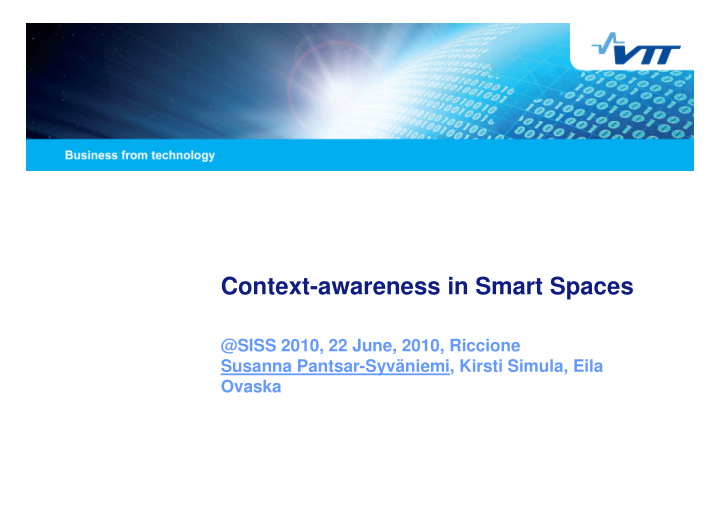



Context-awareness in Smart Spaces @SISS 2010, 22 June, 2010, Riccione Susanna Pantsar-Syväniemi, Kirsti Simula, Eila Ovaska
07/07/2010 2 The main contributions 1) the introduction of a novel context ontology that exploits some parts from SOUPA [3] and the upper context conceptualization presented in [4]; 2) a concept of context-awareness that takes care of context monitoring, context reasoning and context based adaptation; 3) an example scenario used for validating the proposed context- awareness concept within the Smart-M3 architecture [5].
07/07/2010 3 Our context ontology ���� �������� Situation context �������� �������� �������� �������� Digital context of ���� environment �������� ��� ���!�� # �������� ����������� ����������� ��� ��� ���!��� Physical context of "���������� �������� ��������� ���� ������� ������� environment ��������� ���� �������� �������� ������ $��%��& ���� �����
07/07/2010 4 Context agents A context adaptation agent is used for adapting the smart space applications Context Situation based on 1) the current context or 2) based context both the current and the history context. adaptation A context reasoning agent is used by a Digital Context Context smart space application to reason based context of reasoning reasoning on the context information received. environment Physical A context monitoring agent is used by a Context Context Context context of smart space application to follow up its monitoring monitoring monitoring environment scope of the context information. The scope is a set of information, e.g. a threshold of battery level, to be followed up by the context monitoring.
07/07/2010 5 Evaluation criteria for our context ontology “ A context specification is considered a kind of interoperability that sets the following requirements for context definition ” [8]: � Context specification must have comprehensive domain coverage and terminology. � Context specification must be expressive and without semantic ambiguity. � Context specification shall be processed without complexity. � Context specification shall be evolvable.
07/07/2010 6 Context agents in the Smart City scenario
07/07/2010 7 Feasibility of our context ontology � Coverage and terminology : common concepts and properties of context data are covered. Terminology is defined based on the up to date terminology defined by literature and enhanced with history context and quality of context. � Expressive and unambiguous specification ; the ontology includes three dimensions: physical, digital and human. Environment context is enhanced with time, location, quality, history and relationships. OWL was used as representation language because it is expressive and widely adopted in context and ontology modeling. � Uncomplicated processing ; the context specification created with OWL is both machine and human readable and thereby easy to process. The rules, created for our Smart City scenario, were easy to form based on our context ontology. � Evolvability ; the context specification seems to be easy to extend when using OWL based ontologies. This will be studied in future research activities.
07/07/2010 8 Conclusion � Introduced 1) the novel context ontology highlighting the derived context through the three context dimensions and levels, 2) the concept of context-awareness that takes care of context monitoring, context reasoning and context based adaptation, and 3) the Smart City scenario for validating the proposed concept within the extended IOP, i.e. enhanced Smart-M3 architecture. � The validation showed that by using the context aware concept the context-awareness is achieved in the smart space.
07/07/2010 9 Future Work � will concentrate on � implementing the abovementioned smart city scenario to proof our context-awareness concept � will proceed � with the application view of the domain specific ontology to give evidence that it is reachable by a generic agent or a primitive used by the smart (space) applications � will also work towards 1) the separation of concerns between the context model and service architecture model and 2) standardized context ontology to enhance the different kinds of systems, devices, and sensors to be interoperable in the smart spaces.
07/07/2010 10 VTT creates business from technology
Recommend
More recommend